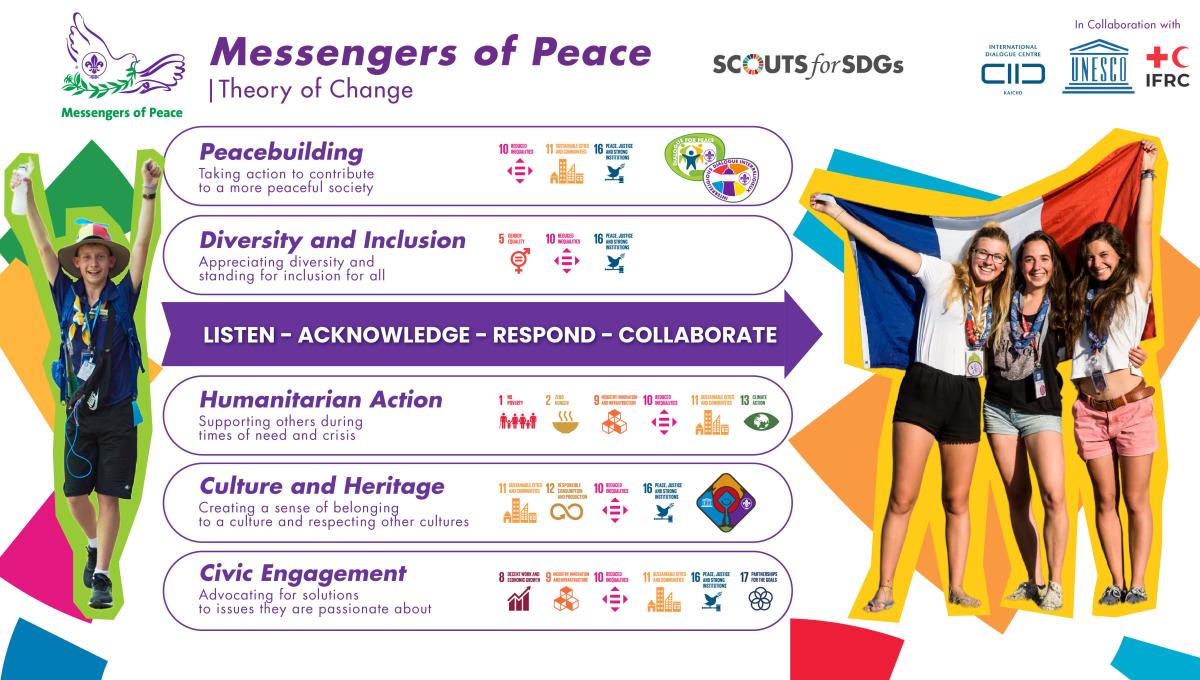Messengers of Peace
Scouts: A Generation of Peace Leaders
The absence of peace is a direct barrier to progress and well-being for all. Let’s extend Scouting's legacy of fostering peace by implementing the Messengers of Peace initiative in National Scout Organizations and groups worldwide! Together, we can replace division with unity and replace violence with harmony.

What is the Messengers of Peace initiative?
This initiative is about creating a global community of peacebuilders who build a culture of kindness, understanding and inclusivity. Messengers of Peace (MoP) seeks to address issues in conflict, disaster and community, such as peacebuilding, humanitarian action in times of disaster, conserving heritage, addressing diversity and inclusion, and more.
The challenges in this initiative give young people the opportunity to explore peace education and community engagement, discover their skills and emotional capability to express empathy and solidarity, and the willingness to explore differences between themselves and others to create positive change.
Through Messengers of Peace, NSOs can empower Scouts to gain a deeper understanding of themselves, step beyond their comfort zones, explore the perspectives of others, and collaborate both within their local communities and on a broader scale.
It is up to you to decide which challenges are a good fit for your country’s context, and how to encourage your Scouts to create a masterPEACE!
Navigating the Learning Paths
With the support of Adult Leaders, Messengers of Peace will guide young people on an educational journey to develop their competencies for sustainable development in the area of peace and community engagement.
Like all WOSM initiatives, Messengers of Peace has a variety of learning paths that young people can take. They can explore one or all - it’s up to them to try as many challenges as they like.

There are five Messengers of Peace learning paths:
1. Peacebuilding
Peacebuilding is about taking action and contributing to more peaceful societies.
Scouts will:
- Recognize and reflect on their personal biases and prejudices
- Practice peaceful conflict resolution
- Build trust with dialogue for social cohesion
2. Diversity and Inclusion
Diversity and Inclusion is about embracing diversity, including everyone in the community, and standing up for people's rights.
Scouts will:
- Develop an appreciation for the unique identities and backgrounds of different individuals within the community
- Gain knowledge about the rights of individuals and the importance of standing up for those rights
3. Humanitarian Action
Humanitarian Action is about supporting others during times of need and crisis.
Scouts will:
- Understand the concepts of disaster mitigation, risk reduction, preparedness, response and recovery
- Learn how to prepare for and respond to disasters to help communities and people affected by them
4. Culture and Heritage
Culture and Heritage is about creating a sense of belonging, respecting other cultures, and preserving all types of heritage.
Scouts will:
- Better understand and appreciate cultures and traditions
- Identify ways to protect cultural heritage to bring communities together
5. Civic Engagement
Civic Engagement is about advocating and taking action on local issues of interest.
Scouts will:
- Engage in advocacy efforts to address local community issues
- Participate in policy-making on issues that they are passionate about
Messengers of Peace Learning Process
The learning process of the Messengers of Peace initiative enables young people to explore and define their educational journey through four milestones:
- Listen: Young people learn about their identity, their rights, and how their good deeds can inspire others.
- Aknowledge: Young people learn to respect and value people's differences and support those who are struggling by standing up for their rights.
- Respond: Young people discover ways to create more peaceful communities by recognizing how personal actions affect others, identifying issues in their community and coming up with ideas to create safe spaces for mutual understanding.
- Collaborate: Finally, young people collaborate with others to implement projects, such as community projects, education campaigns, and advocacy efforts, to promote conversation, dialogue, peacebuilding, and mutual understanding.



